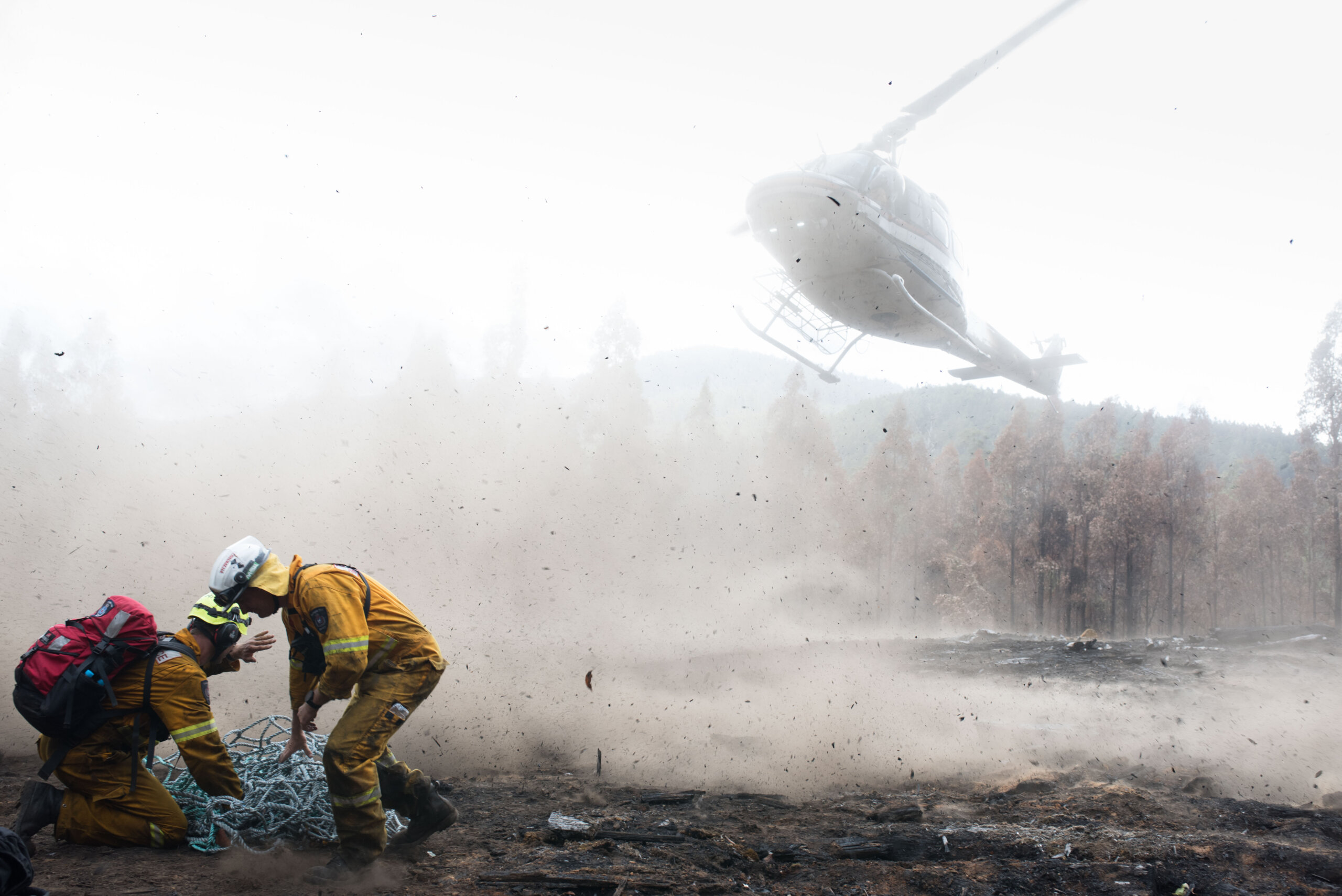Wild – Fire and Rescue
Warren Frey + Richard Bugg
5 February – 3 April, 2022
The images in this exhibition evolved from a specific context. Both Warren and I were at work in remote environments with the emergency services when the photographs were taken – Warren as a Firefighter, and myself as a Flight Paramedic.
Taking photographs on remote-area fire-grounds, and during search-and-rescue operations is necessarily subservient to the primary tasks at hand – firefighting, rescue, and patient care.
Consequently, the opportunity to wield a camera in these circumstances is fleeting at best, and often doesn’t even eventuate. But at times there is a lull in operations, or the burden of immediate responsibility is not very high. In those moments, the possibility arises to reach for the camera to try to record something of what is happening around us.
The selection of images forms part of an ongoing project to document our work in the emergency services. Not just as photographers, but as participants in unfolding events. As such, we have a unique perspective not readily accessible to others.

Grit, Warren Frey, Tasmanian Fire Service.
We hope this insight into perspectives of the emergency responder deepens your appreciation and respect for the wild and beautiful Tasmanian landscape and of the work done by Tasmania’s emergency services.
With thanks for support from Ambulance Tasmania, the Tasmania Fire Service and Tasmania Police.
Richard Bugg and Warren Frey
Image Captions for exhibited works
1
Firebird down | Warren Frey
Steep terrain, high winds and heavy smoke means flying in a wildfire environment is not without risk. The pilot made a lucky escape, and was rescued by fellow pilots who lifted him to safety in a water bucket. Molesworth.
2
Arthur River, takanya/Tarkine | Richard Bugg
On his final supervised winch before being signed off as independent, Adam swings through the canopy of forest bordering the Arthur River with a tourist who became stranded by the swollen river. The takanya/Tarkine region contains Australia’s largest remaining tract of temperate rainforest and its natural and archaeological values are of global significance.
3
Mersey River, Cradle Mt – Lake St Clair National Park | Richard Bugg
After collecting a walker with a leg injury from near Kia Ora Hut on the Overland Track we follow the Mersey River upstream as it cuts through a belt of cool temperate rainforest. The helicopter’s shadow can be seen in the forest above Fergusson Falls. Further downstream and at the extreme upper right of the image, a group of walkers can be made out viewing D’Alton Falls from a ledge.
4
Fatality, Lyell Highway | Richard Bugg
Tasmanian Crash Statistics*
10 Year Average: 35.8 (fatalities), 270.9 (serious injuries)
*Tasmanian Department of state growth, Transport, accessed 11 September 2018, <https://www.transport.tas.gov.au/road_safety_and_rules/crash_statistics>
5
Wildflowers | Warren Frey
The helicopter pilot strafes the fire edge with thousands of litres of water. Ground and air crews work closely together to control vast edges of active fire in areas in-accessible by road. Once the water drop is completed, fire crews move in to smother and extinguish the remnants of fire with hand tools.The aircraft will quickly refill and return, ready to begin working on the next section of fire. Mount Wright, Gell River Fire.
6
Grit | Warren Frey
Remote Area Firefighters (RAT’s) prepare to load an incoming helicopter at the end of a hot, dry and dusty day. Firefighters from Tasmania, New South Wales and New Zealand spent many days working to extinguish smouldering fires in thick tea tree bush at the base of the Hartz Mountains National Park.
7
Skelly | Warren Frey
One of three brothers who all work in the Hobart Fire Brigade. Shaun Skelly is in his element here, in the bush taking a break after digging up burning peat from the dry rainforest floor. The tree to the right has been cut down to make an opening for the in-bound helicopter that will soon be dropping water through the gap in the canopy. Hartz Mountains.
8
When Rainforests Burn | Warren Frey
And now we find ourselves in the rainforest, no longer cool and wet, no longer a quiet place. The air is hot and humid, sunlight pierces through the peat tainted smoke, warming the ground so that the smouldering fires beneath burst back into life. The sound of ancient trees crashing down through the canopy warns of the impending fire, creeping towards ancient Huon Pines that have stood firmly on the river bank for hundreds of years.
9
Enervation | Warren Frey
Walking the fire boundary for hours. The day is hot and dry. But, finally, there is relief in finding a well-hidden helipad amongst the scorched tea tree. Waiting to leave this place. Maxwell River Fire, Franklin Gordon Wild Rivers National Park.
10
Decimated | Warren Frey
As far as the eye can see – an area of the Tarkine lay’s waste to the ravages of fire. Sadly, this area is an important habitat to the endangered Tasmanian Devil. We bear witness to this destruction – an unfathomable loss of life disappears before our very eyes.
11
Apocalypse | Warren Frey
A water bombing aircraft returns to the Celtic Hill Fire after re-filling a water bucket from nearby Lake Pedder. The task at hand can often feel overwhelming. Celtic Hill, South West National Park.
12
Extraction | Warren Frey
At the end of day two we wait for the distant thud of the approaching helicopter. Tired and fatigued, we notice the new growth emerging a week after the fire had passed through. The machine that delivers us to and from this wild place interrupts our reprieve. Tomorrow we will be back here. South West National Park.
13
Descent | Warren Frey
What could be mistaken for mist is smoke haze tainted with the distinct smell of burning peat. A helicopter descends the through haze to transport Remote Area Firefighters (RAT’s) into the fire ravaged South West National Park.
14
The Sentinels | Warren Frey
First impressions are deceiving – the powerful Sentinel Range stands guard over the South West National Park as smoke wisps skywards. But, height is no barrier to fire. Fire can double its speed every 10 degrees of slope – increasing in intensity and heat. But, once it reaches the other side, the intensity and the heat of the fire plummets.
15
Scorched Valley | Warren Frey
Coming into the abyss – a water-bombing helicopter transports Remote Area Firefighters (RAT’s) into a fire-ravaged area of the South West National Park. The Sentinel Range looms in the background.
16
Beneath the Canopy | Warren Frey
The relentless rainforest floor – Remote Area Firefighters (RAT’s) drag hundreds of metres of hose under and over natural obstacles encountered on the rainforest floor. Sometimes to extinguish an area of smouldering peat no more than a few metres square. South West National Park.
17
Mount Anne | Warren Frey
Bushwalkers were evacuated by helicopter from the path of fires that devastated vast areas of the South West National Park.
18
Frenchman’s Cap | Richard Bugg
The plight of a young boy with a ruptured appendix on Tasmania’s West Coast leads to helicopter deployment of a Doctor and Paramedic retrieval team. Our route from Hobart took us past Frenchman’s Cap, still covered in a mantle of late winter snow.
19
Symmetry, Wynyard Airport | Richard Bugg
Mick (L) and Rod, appear lost in thought while waiting for the aircraft engines to come to rest during a refuelling stop at Wynyard airport. After a morning searching bushland for a young woman missing, we have just received news that she had not survived.
20
Thark Ridge, kunanyi (Mt Wellington) | Richard Bugg
Having found the man by the side of the track, his life extinguished, there was nothing more to be accomplished for the night. We settled into our tents for the remainder of the evening as snow began to fall. By morning, a white blanket had settled around us. I awoke early to a clear sky and still morning and walked along a nearby ridge to an outcrop of snow-dusted rocks.
21
Alpine recovery, kunanyi | Richard Bugg
In the morning helpers arrive to lend a hand. With the scene examined documented by the forensics team, the extrication began. We haul and slide, slip and grunt, sweat and swear. The passage of the sun through the sky while we work is a reminder that we all have limited time.
22
Night Vision, Derwent River | Richard Bugg
Night vision goggles provide crew members with enhanced search capabilities during night operations. This image captures the moment after an irregular shape was spotted in the water. The police boat was directed to the location via direction from the aircrew, and the man’s body was recovered.
23
Wave, Friendly Beaches | Richard Bugg
Our search for a young man presumed drowned with his six-year-old son at Bicheno while rock fishing continued through several days. As we flew over the Friendly Beaches to a nearby airstrip to refuel, waves peeled into the white sands in a display of exquisite beauty that belied the tragic circumstances of our enterprise.
24
South Cape Rivulet | Richard Bugg
Searching for a missing walker we land at South Cape Rivulet to interview hikers gathered on the beach. Sand, water and shadows hint at the ephemeral nature of all things.
Works Outside Gallery Space
25
Neale Smith, Winch Training | Richard Bugg
Winching from a helicopter into remote environments is a complex and at times difficult procedure, requiring regular training drills to consolidate skills and teamwork. In this case Neale is being lowered to the ground by the helicopter’s winch during a training exercise with photographer Richard Bugg.
26
Winter Training, Acropolis | Richard Bugg
Police officers load climbing equipment into the BK117 helicopter during the annual Search and Rescue Exercise (SAREX) on the slopes of The Acropolis, Cradle Mt – Lake St Clair National Park. The arrival of the helicopter produces a hurricane of wind and noise and has rescuers hunkered down as the pilot manoeuvres delicately into place. Unable to land on uneven terrain the aircraft maintains a low hover to allow personnel and equipment to be loaded and unloaded.
27
Blizzard, Mt King William | Richard Bugg
Keith (L) and Drew ascend the slopes of Mt King William during a winter training exercise. Snowfall can catch bushwalkers unaware and unprepared throughout the year, and rescue teams need to be ready to work in a wide range of conditions.

